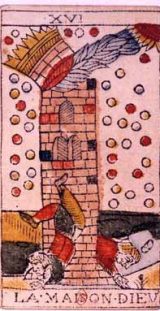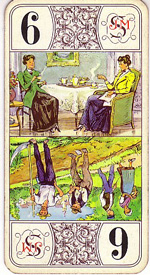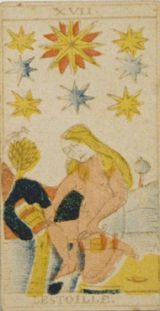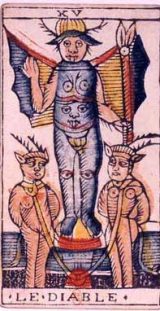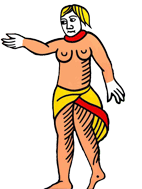

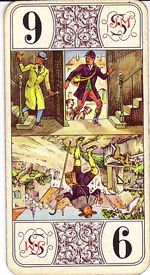

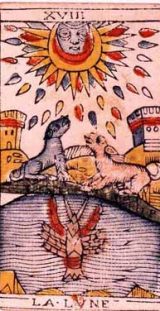
At the end of the 18th century, Court de Gébelin, in line with the views of a burgeoning Freemasonry, claimed that the Tarot expressed the hidden knowledge of the ancients, a wisdom originating in pharonic Egypt.
The 19th century would accept this version of the Tarot wholeheartedly, drawing it increasingly away from a pub game and conferring on it an ever more esoteric and divinatory character. New York tarot reader Enrique Enriquez sees this process as a virtual kidnapping of tarot source material, and expresses himself in no uncertain terms.
In the 20th century, these two versions have come to coexist. On the one hand is the game called Federation, devoid of all esotericism, with images issued from the popular press at Epinal. It contains the habitual four suits: Spades, Hearts, Diamonds and Clubs. On the other hand, innumerable artistic or divinatory Tarots proliferated. These were not destined to be played as a game.
The Tarot “of Marseille”
The Tarot’s major arcana (the 22 added trumps) are a coded description of an individual’s journey through life, from incarnation to liberation. The scene has always been shared by two pictorial traditions.
The “Milanese” tradition, that of the image-makers, is represented by the Tarot “of Marseille”, the city-name referring to a style rather than to its place of origin. In any case, the oldest extant printed deck comes not from Marseille, but from the mid-17th century Paris atelier of Jean NOBLET. Issued from this tradition are also the tarot of Jean DODAL (Lyon, c. 1701/1715), that of Jean-Pierre PAYEN (Avignon, 1713), and the famous tarot of Nicolas Conver (Marseille, 1760).
The Piedmontese pictorial tradition, that of foremen and stonecutters, is known also as the Tarot of Bologna (itself issued from a Rouen-Brussels tradition) and is principally expressed in the Tarot of Jacques VIEVILLE(Paris, 1650).
The Marseille Tarot presents significant graphic differences with that of Bologna. In arcanum XV, The Devil is seen full-face rather than in profile. In arcanum XVI, The House of God, a tower erupting in flames is replaced by a shepherd with his flock at the foot of a tree. The Star, arcanum XVII, substitutes a pregnant woman for an architect, while in The Moon, arcanum XVIII, a pool sheltering a crayfish becomes a spinner with a spindle.
One can cite a third tradition, one that appears at the beginning of the 15th century: artistic tarots. This tradition originates with the princely decks (probably used for divination) already mentioned, and continues to this day. Even Salvadore Dali painted his own Tarot!
It is useless to try and draw any inner meaning from these often beautiful works. The aesthetic process takes complete precedence over the veritable traditional science.
